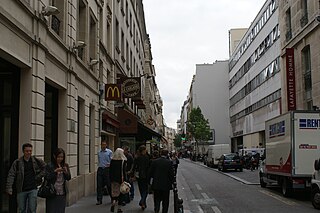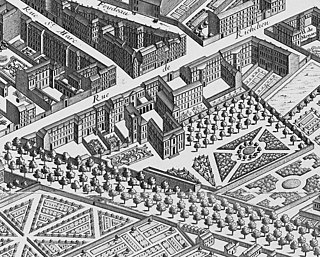
The 7th arrondissement of Paris is one of the 20 arrondissements of the capital city of France. In spoken French, this arrondissement is referred to as le septième.

The 1st arrondissement of Paris is one of the 20 arrondissements of the capital city of France. In spoken French, this arrondissement is colloquially referred to as le premier. It is governed locally together with the 2nd, 3rd and 4th arrondissement, with which it forms the 1st sector of Paris (Paris-Centre).

The Hôtel de Ville is the city hall of Paris, France, standing on the Place de l'Hôtel-de-Ville – Esplanade de la Libération in the 4th arrondissement. The south wing was originally constructed by François I beginning in 1535 until 1551. The north wing was built by Henry IV and Louis XIII between 1605 and 1628. It was burned by the Paris Commune, along with all the city archives that it contained, during the Semaine Sanglante, the Commune's final days, in May 1871. The outside was rebuilt following the original design, but larger, between 1874 and 1882, while the inside was considerably modified. It has been the headquarters of the municipality of Paris since 1357. It serves multiple functions, housing the local government council, since 1977 the Mayors of Paris and their cabinets, and also serves as a venue for large receptions.

The Hôtel Biron, known initially as the Hôtel Peyrenc-de-Moras and later as the Hôtel du Maine, is an hôtel particulier located at 77 rue de Varenne, in the 7th arrondissement of Paris, that was built from 1727 to 1732, to the designs of the architect Jean Aubert. Since 1919, it has housed the Musée Rodin, dedicated to the work of Auguste Rodin.

Pierre-Louis Moreau-Desproux was a pioneering French neoclassical architect.

The Hôtel de Bourbon-Condé is an hôtel particulier, a kind of large townhouse in France, at 12 Rue Monsieur, in the 7th arrondissement of Paris. It was built for Louise Adélaïde de Bourbon by architect Alexandre-Théodore Brongniart.

Boulevard Raspail is a boulevard of Paris, in France.

The Hôtel de Beauvais is a hôtel particulier, a kind of large townhouse of France, at 68 rue Francois-Miron, 4th arrondissement, Paris. Until 1865 rue Francois-Miron formed part of the historic rue Saint Antoine and as such was part of the ceremonial route into Paris from the east. The hotel was built by the royal architect Antoine Le Pautre for Catherine Beauvais in 1657. It is an example of eclectic French baroque architecture.

The rue de Provence is a street located in the 8th and 9th Arrondissements of Paris. It begins at the rue du Faubourg Montmartre and ends at the rue de Rome. Only the short part of the street between rue du Havre and rue de Rome is in the 8th arrondissement.

Passage Choiseul is one of the covered passages of Paris, France located in the 2nd arrondissement. It is the continuation of Rue de Choiseul.

The Rue Saint-Lazare is a street in the 8th and 9th arrondissements of Paris, France. It starts at 9 Rue Bourdaloue and 1 Rue Notre-Dame-de-Lorette, and ends at Place Gabriel-Péri and Rue de Rome.
This article presents the main landmarks in the city of Paris within administrative limits, divided by its 20 arrondissements. Landmarks located in the suburbs of Paris, outside of its administrative limits, while within the metropolitan area are not included in this article.

The city of Paris has notable examples of architecture of every period, from the Middle Ages to the 21st century. It was the birthplace of the Gothic style, and has important monuments of the French Renaissance, Classical revival, the Flamboyant style of the reign of Napoleon III, the Belle Époque, and the Art Nouveau style. The great Exposition Universelle (1889) and 1900 added Paris landmarks, including the Eiffel Tower and Grand Palais. In the 20th century, the Art Deco style of architecture first appeared in Paris, and Paris architects also influenced the postmodern architecture of the second half of the century.
The concours de façades de la ville de Paris was an architecture competition organized by the city of Paris at the very end of the 19th century.

The Hôtel de Crozat, later the Hôtel de Choiseul, was a Parisian hôtel particulier, constructed in 1704 to the designs of the French architect Jean-Sylvain Cartaud for the rich banker and art collector Pierre Crozat. It was located on the west side of the rue de Richelieu, south of its intersection with the Grand Boulevard. The Duke of Choiseul acquired the hôtel in 1750. It was demolished in 1780, the property subdivided, and a theatre, the Salle Favart, constructed in the former garden.

Rue de Harlay is a street on the Île de la Cité in the 1st arrondissement of Paris, France.

The Rue des Archives is a street in The Marais at the border of 3rd and 4th arrondissements of Paris, France.

The expansion of the Louvre under Napoleon III in the 1850s, known at the time and until the 1980s as the Nouveau Louvre or Louvre de Napoléon III, was an iconic project of the Second French Empire and a centerpiece of its ambitious transformation of Paris. Its design was initially produced by Louis Visconti and, after Visconti's death in late 1853, modified and executed by Hector Lefuel. It represented the completion of a centuries-long project, sometimes referred to as the grand dessein, to connect the old Louvre Palace around the Cour Carrée with the Tuileries Palace to the west. Following the Tuileries' arson at the end of the Paris Commune in 1871 and demolition a decade later, Napoleon III's nouveau Louvre became the eastern end of Paris's axe historique centered on the Champs-Élysées.


















